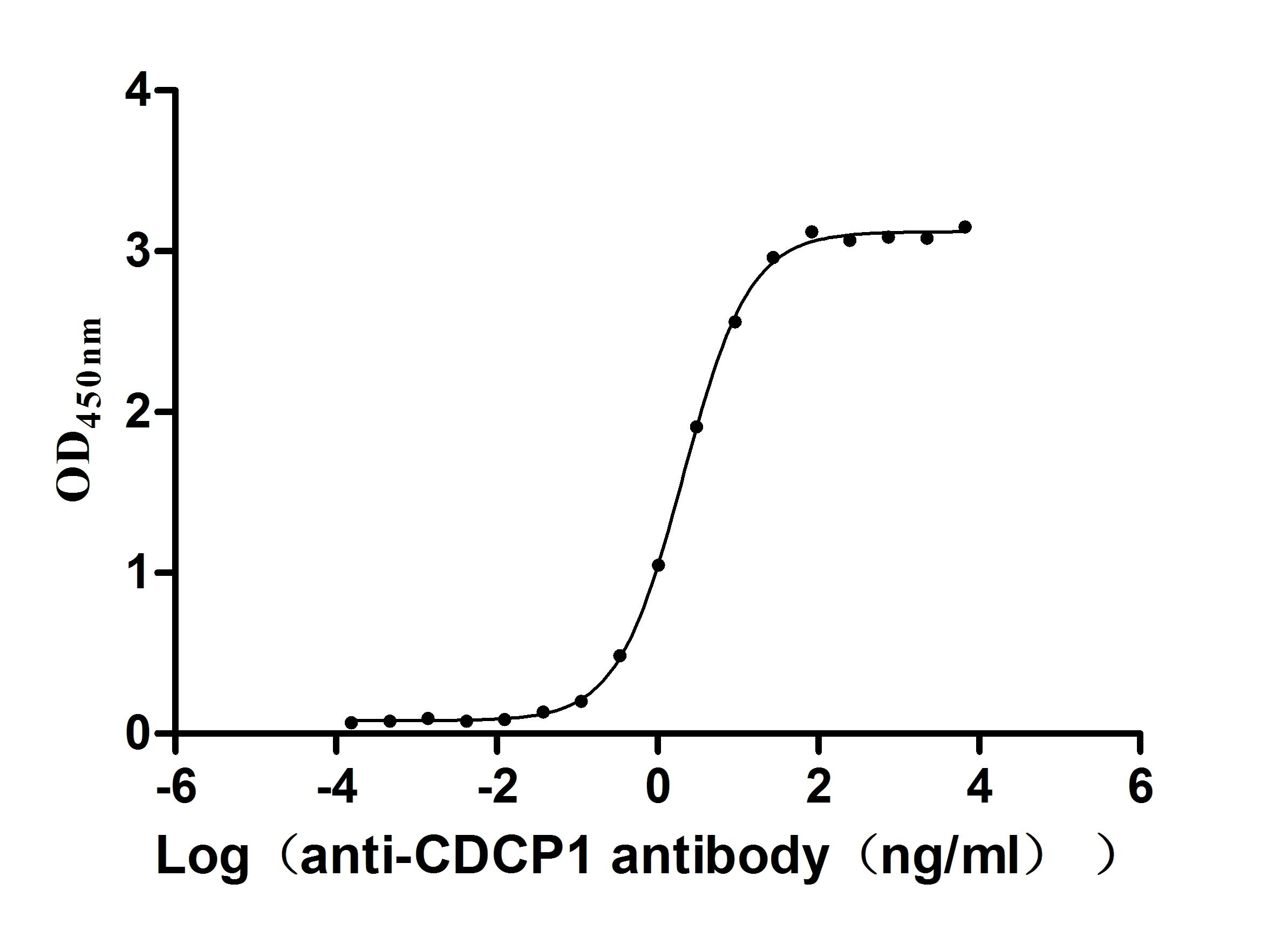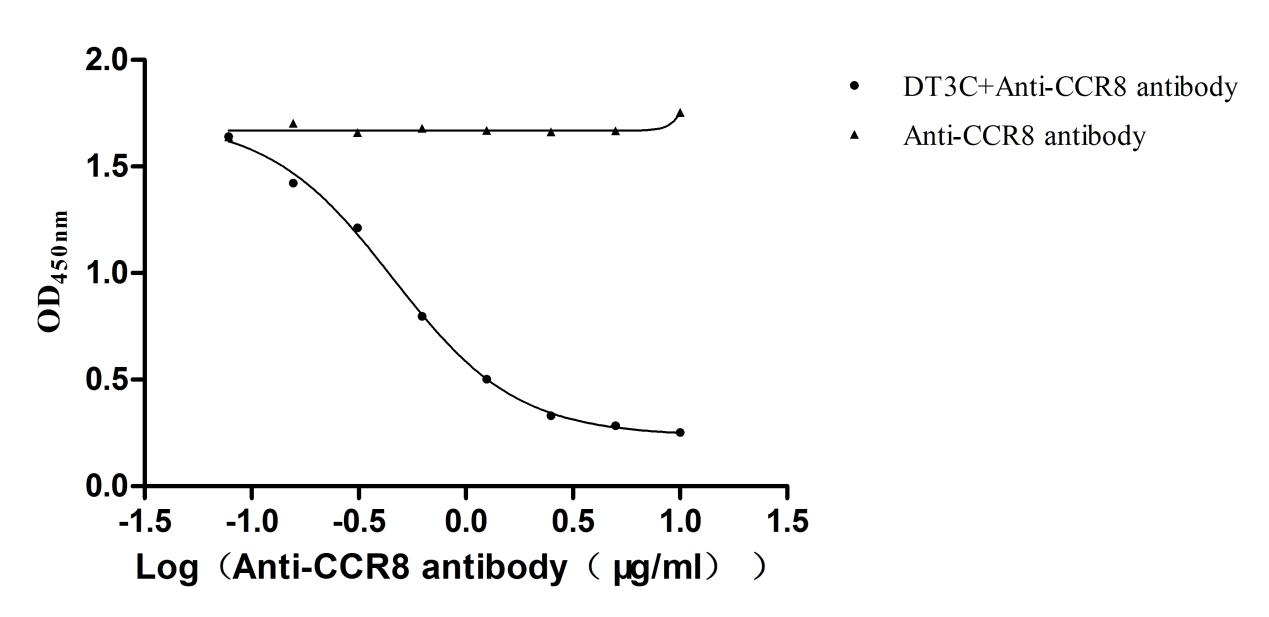Recombinant Human Targeting protein for Xklp2 (TPX2)
Unavailable-
中文名称:人TPX2重组蛋白
-
货号:CSB-YP892151HU
-
规格:
-
来源:Yeast
-
其他:
-
中文名称:人TPX2重组蛋白
-
货号:CSB-EP892151HU
-
规格:
-
来源:E.coli
-
其他:
-
中文名称:人TPX2重组蛋白
-
货号:CSB-EP892151HU-B
-
规格:
-
来源:E.coli
-
共轭:Avi-tag Biotinylated
E. coli biotin ligase (BirA) is highly specific in covalently attaching biotin to the 15 amino acid AviTag peptide. This recombinant protein was biotinylated in vivo by AviTag-BirA technology, which method is BriA catalyzes amide linkage between the biotin and the specific lysine of the AviTag.
-
其他:
-
中文名称:人TPX2重组蛋白
-
货号:CSB-BP892151HU
-
规格:
-
来源:Baculovirus
-
其他:
-
中文名称:人TPX2重组蛋白
-
货号:CSB-MP892151HU
-
规格:
-
来源:Mammalian cell
-
其他:
产品详情
-
纯度:>85% (SDS-PAGE)
-
基因名:TPX2
-
Uniprot No.:
-
别名:C20ORF1; C20orf2; Chromosome 20 Open Reading Frame 1; Differentially expressed in cancerous and non-cancerous lung cells 2; Differentially expressed in cancerous and noncancerous lung cells 2; Differentially expressed in lung cells 2; Differentially expressed in lung cells; DIL 2; DIL-2; DIL2; FLS353; GD:C20orf1; HCA 519; HCA519; HCTP 4; HCTP4; Hepatocellular carcinoma associated antigen 519; Hepatocellular carcinoma-associated antigen 519; p100; Preferentially expressed in colorectal cancer; Protein fls353; REPP 86; repp86; Restricted expression proliferation associated protein 100; Restricted expression proliferation-associated protein 100; Targeting protein for Xklp2; TPX 2; TPX2; TPX2 microtubule associated homolog; TPX2 microtubule associated protein homolog; TPX2 microtubule nucleation factor; TPX2_HUMAN
-
种属:Homo sapiens (Human)
-
蛋白长度:full length protein
-
表达区域:1-747
-
氨基酸序列MSQVKSSYSY DAPSDFINFS SLDDEGDTQN IDSWFEEKAN LENKLLGKNG TGGLFQGKTP LRKANLQQAI VTPLKPVDNT YYKEAEKENL VEQSIPSNAC SSLEVEAAIS RKTPAQPQRR SLRLSAQKDL EQKEKHHVKM KAKRCATPVI IDEILPSKKM KVSNNKKKPE EEGSAHQDTA EKNASSPEKA KGRHTVPCMP PAKQKFLKST EEQELEKSMK MQQEVVEMRK KNEEFKKLAL AGIGQPVKKS VSQVTKSVDF HFRTDERIKQ HPKNQEEYKE VNFTSELRKH PSSPARVTKG CTIVKPFNLS QGKKRTFDET VSTYVPLAQQ VEDFHKRTPN RYHLRSKKDD INLLPSKSSV TKICRDPQTP VLQTKHRARA VTCKSTAELE AEELEKLQQY KFKARELDPR ILEGGPILPK KPPVKPPTEP IGFDLEIEKR IQERESKKKT EDEHFEFHSR PCPTKILEDV VGVPEKKVLP ITVPKSPAFA LKNRIRMPTK EDEEEDEPVV IKAQPVPHYG VPFKPQIPEA RTVEICPFSF DSRDKERQLQ KEKKIKELQK GEVPKFKALP LPHFDTINLP EKKVKNVTQI EPFCLETDRR GALKAQTWKH QLEEELRQQK EAACFKARPN TVISQEPFVP KKEKKSVAEG LSGSLVQEPF QLATEKRAKE RQELEKRMAE VEAQKAQQLE EARLQEEEQK KEELARLRRE LVHKANPIRK YQGLEIKSSD QPLTVPVSPK FSTRFHC
-
蛋白标签:Tag type will be determined during the manufacturing process.
The tag type will be determined during production process. If you have specified tag type, please tell us and we will develop the specified tag preferentially. -
产品提供形式:Lyophilized powder
Note: We will preferentially ship the format that we have in stock, however, if you have any special requirement for the format, please remark your requirement when placing the order, we will prepare according to your demand. -
复溶:We recommend that this vial be briefly centrifuged prior to opening to bring the contents to the bottom. Please reconstitute protein in deionized sterile water to a concentration of 0.1-1.0 mg/mL.We recommend to add 5-50% of glycerol (final concentration) and aliquot for long-term storage at -20℃/-80℃. Our default final concentration of glycerol is 50%. Customers could use it as reference.
-
储存条件:Store at -20°C/-80°C upon receipt, aliquoting is necessary for mutiple use. Avoid repeated freeze-thaw cycles.
-
保质期:The shelf life is related to many factors, storage state, buffer ingredients, storage temperature and the stability of the protein itself.
Generally, the shelf life of liquid form is 6 months at -20°C/-80°C. The shelf life of lyophilized form is 12 months at -20°C/-80°C. -
货期:Delivery time may differ from different purchasing way or location, please kindly consult your local distributors for specific delivery time.Note: All of our proteins are default shipped with normal blue ice packs, if you request to ship with dry ice, please communicate with us in advance and extra fees will be charged.
-
注意事项:Repeated freezing and thawing is not recommended. Store working aliquots at 4°C for up to one week.
-
Datasheet :Please contact us to get it.
相关产品
靶点详情
-
功能:Spindle assembly factor required for normal assembly of mitotic spindles. Required for normal assembly of microtubules during apoptosis. Required for chromatin and/or kinetochore dependent microtubule nucleation. Mediates AURKA localization to spindle microtubules. Activates AURKA by promoting its autophosphorylation at 'Thr-288' and protects this residue against dephosphorylation. TPX2 is inactivated upon binding to importin-alpha. At the onset of mitosis, GOLGA2 interacts with importin-alpha, liberating TPX2 from importin-alpha, allowing TPX2 to activates AURKA kinase and stimulates local microtubule nucleation.
-
基因功能参考文献:
- A PRISMA-compliant systematic review and meta-analysis found that overexpression of TPX2 is related to poor survival rate in most solid tumors, which indicates that the expression level of TPX2 is a significant prognostic parameter and potential therapeutic target in various solid tumors. PMID: 30412141
- Study suggests AURKA and TPX2 as potential stratification markers for taxane-based radiochemotherapy. lung adenocarcinoma cohort, high expression levels of AURKA and TPX2 were associated with specifically improved overall survival upon taxane-based radiochemotherapy. PMID: 28869599
- Data found that TPX2 was highly expressed in human bladder cancer tissues. Its overexpression promoted bladder cancer growth and correlated with tumor grade and stage, lymph node metastasis, and poor prognosis. These results support that TPX2 acts as a tumor promoter in human bladder tumor development. PMID: 28799673
- TPX2 promotes the proliferation and migration of human OC cells by regulating PLK1 expression. PMID: 29865033
- Together, these results suggest a molecular mechanism of how the Ran-GTP gradient can regulate TPX2-dependent microtubule formation. PMID: 29120325
- TPX2 was correlated with cell radioresistance PMID: 28636807
- We show TPX2, a regulator of Aurora-A, is associated with high grade and stage of ccRCC, and is an independent predictor of recurrence. PMID: 28108243
- detection of TPX2 overexpression could serve as a prognostic marker and therapeutic target for gastric cancer PMID: 27314162
- High TPX2 expression is associated with gastric cancer. PMID: 28069036
- This study concludes that the helical region of TPX2 folds upon binding Aurora-A, and that stabilization of this helix does not compromise Aurora-A activation. PMID: 27775325
- MiR-491 inhibits hepatocellular carcinoma cell proliferation, invasion and migration by downregulating the expression of TPX2. PMID: 27053618
- expression of both TPX2 and PD-L1 are associated with persistence/recurrence of cervical intraepithelial neoplasia after cervical conization PMID: 26624896
- the levels and distribution of TPX2 are likely to be determinants of when and where kinesin-5 acts in neurons. PMID: 26257190
- TPX2 was a target gene of miR-491. PMID: 26279431
- Propose TPX2 and AURKA as novel co-regulators on the MYC pathway in colorectal neoplasms. PMID: 25632068
- Aurora A-dependent TPX2 phosphorylation controls mitotic spindle length through regulating microtubule flux. PMID: 26240182
- These results indicated that TPX2 has an impact on tumor angiogenesis in pancreatic cancer. PMID: 25914189
- Data show that cytoskeleton associated protein 5 (chTOG) only weakly promotes importin-regulated microtubule nucleation, but acts synergistically with TPX2 protein. PMID: 26414402
- RAN nucleo-cytoplasmic transport and mitotic spindle assembly partners XPO7 and TPX2 have roles in serous epithelial ovarian cancer PMID: 24625450
- a causative link between altered function of AURKA-HMMR-TPX2-TUBG1 and breast carcinogenesis in BRCA1/2 mutation carriers PMID: 25830658
- Identify RHAMM as a critical regulator of TPX2 location/ Aurora kinase A signaling and suggest that RHAMM ensures bipolar spindle assembly and mitotic progression through the integration of biochemical and structural pathways. PMID: 24875404
- the molecular mechanisms of two distinct activation strategies (autophosphorylation and TPX2-mediated activation) in human Aurora A kinase, was elucidated. PMID: 24867643
- Dimeric, but not monomeric, Eg5 was differentially inhibited by full-length and truncated TPX2, demonstrating that dimerization or residues in the neck region are important for the interaction of TPX2 with Eg5. PMID: 26018074
- our study is the first indication of a constitutive control of TPX2 on H4K16ac levels, with potential implications for DNA damage response. PMID: 25365214
- TPX2 siRNA transfection significantly reduced tumor growth. PMID: 25239289
- In vitro studies found that TPX2 knockdown significantly inhibited cell proliferation and viability in both Hep3B and HepG2 cells. PMID: 25302620
- TPX2 expression is associated with cell proliferation and poor prognosis among patients with resected esophageal squamous cell carcinoma PMID: 23963785
- TPX2 overexpression is associated with medullary thyroid carcinoma. PMID: 24488334
- The results demonstrated that TPX2 is important in the regulation of tumor growth in cervical cancer and therefore may be a potential therapeutic target as a novel treatment strategy. PMID: 24718984
- TPX2 plays an important role in promoting tumorigenesis and metastasis of human colon cancer, and may represent a novel prognostic biomarker and therapeutic target for the disease PMID: 24341487
- This review provides an historic overview of the discovery of TPX2 and summarizes its cytoskeletal and signaling roles with relevance to cancer therapies. [review] PMID: 24556998
- The expression of TPX2 protein and mRNA were correlated with invasive depth and lymphatic metastasis of esophageal squamous cell carcinoma. PMID: 23725757
- Data indicate that TPX2 (target protein for Xklp2) may play a role in the development and progression of bladder carcinoma, and suggest that inhibition of TPX2 level may be a novel strategy for therapy of the patients with bladder carcinoma. PMID: 23873098
- The data support the role of TPX2 as a novel co-activator of Aurora kinase B. PMID: 22560880
- Data show that five genes CKAP5, KPNB1, RAN, TPX2 and KIF11 were shown to be essential for tumor cell survival in both head and neck squamous cell carcinoma (HNSCC)and non-small cell lung cancer (NSCLC), but most particularly in HNSCC. PMID: 23444224
- Data indicate that the sensitivity of cell-lines with amplification of AURKA depends upon the activity of the kinase, which correlates with the expression of the regulatory gene products TPX2 and HMMR/RHAMM. PMID: 23328114
- the regulation of gamma-H2AX signals by TPX2 is not associated with apoptosis or the mitotic functions of TPX2. PMID: 23045526
- AIM1, ERGIC1, and TPX2 were shown to be highly expressed especially in prostate cancer tissues, and high mRNA expression of ERGIC1 and TMED3 associated with AR and ERG oncogene expression PMID: 22761906
- TPX2 promote 20q amplicon-driven progression of colorectal adenoma to carcinoma. PMID: 22207630
- TPX2 shows potential to be used as a new marker for cervical cancer diagnosis and therapy. PMID: 22307108
- two switches determining Aurora A activation PMID: 21347367
- TPX2 protects Aurora-A from degradation both in interphase and in mitosis. PMID: 21147853
- Results demonstrate a role for PP6 as the T-loop phosphatase regulating Aurora A activity bound to its activator TPX2 during mitotic spindle formation. PMID: 21187329
- association of Aurora-A and TPX2 gives rise to a novel functional unit with oncogenic properties.[review] PMID: 20708655
- Decreased AurA-TPX2 complex formation in response to irradiation results from reduced cellular levels of TPX2, as a result of protein degradation and decreased translation of TPX2 mRNA. PMID: 21099343
- TPX2 expression is associated with the progression of malignant astrocytoma. PMID: 20599806
- Data show that Aurora A(S155R) mutant reduced cellular activity and mislocalization are due to loss of interaction with TPX2. PMID: 19801554
- TPX2 is required for targeting Aurora-A kinase to the spindle apparatus and Aurora-A might regulate the function of TPX2 during spindle assembly PMID: 12177045
- spindle formation requires the function of TPX2 to generate a stable bipolar spindle with overlapping antiparallel microtubule arrays PMID: 12389033
- observations reveal a structural role for hTPX2 in spindles and provide evidence for a balance between microtubule-based motor forces and structural spindle components PMID: 12477396
显示更多
收起更多
-
亚细胞定位:Nucleus. Cytoplasm, cytoskeleton, spindle. Cytoplasm, cytoskeleton, spindle pole.
-
蛋白家族:TPX2 family
-
组织特异性:Expressed in lung carcinoma cell lines but not in normal lung tissues.
-
数据库链接:
HGNC: 1249
OMIM: 605917
KEGG: hsa:22974
STRING: 9606.ENSP00000300403
UniGene: Hs.244580
Most popular with customers
-
Recombinant Human Cytokine receptor common subunit beta (CSF2RB), partial (Active)
Express system: Mammalian cell
Species: Homo sapiens (Human)
-
Express system: Mammalian cell
Species: Macaca fascicularis (Crab-eating macaque) (Cynomolgus monkey)
-
Express system: Mammalian cell
Species: Homo sapiens (Human)
-
Recombinant Human Cell adhesion molecule 1 (CADM1), partial (Active)
Express system: Mammalian cell
Species: Homo sapiens (Human)
-
Recombinant Macaca fascicularis CUB domain containing protein 1 (CDCP1), partial (Active)
Express system: Mammalian cell
Species: Macaca fascicularis (Crab-eating macaque) (Cynomolgus monkey)
-
Recombinant Human Tumor necrosis factor ligand superfamily member 15(TNFSF15) (Active)
Express system: Mammalian cell
Species: Homo sapiens (Human)
-
Recombinant DT3C (Diphtheria toxin & spg 3C domain) for Antibody Internalization Assay (Active)
Express system: E.coli
Species: N/A







-AC1.jpg)











